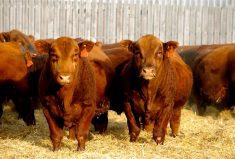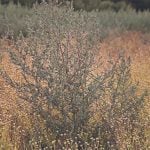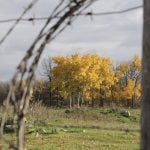The debate is over on whether internal parasites are developing resistance to dewormers in Canadian cow herds, as far as the research is concerned. But while researchers can offer some general principles, ranchers will need to get a little creative to figure out how to manage it on their own operations.
Dr. John Gilleard is a professor of parasitology and associate dean at the University of Calgary’s faculty of veterinary medicine. He thinks there’s “a culture change needed, where producers and veterinarians are thinking more directly about how we reduce our dependence on these dewormer products.”
Gilleard and his colleagues did a study six or seven years ago looking at the efficacy of pour-on ivermectin. They found fecal egg counts only dropped by about half after producers treated cattle. “Overall, it’s varied from herd to herd, but roughly that was the case. So that was the first inkling that there was a problem with the efficacy of these products here.”
Read Also

Canadian Beef Check-Off Agency reports on investments and activities
The check-off agency’s work behind the scenes is what ensures cattle check-off dollars are invested wisely, accounted for transparently and deliver measurable value back to producers and importers.
More recently, they did a “more formal test of resistance” with Dr. Fabienne Uehlinger at the Western College of Veterinary Medicine at the University of Saskatchewan. The study was a controlled trial of calves entering the feedlot. Drugs were applied in a “carefully controlled manner,” says Gilleard. Researchers sourced calves from a wide area across Saskatchewan and counted fecal eggs before and after treatment. Fecal egg counts for the treatment group after deworming were about the same as the previous study, he adds. Molecular analysis also found resistance in multiple parasitic species.
“From the different studies we’ve done, we think we can say that ivermectin resistance is widespread.”
He adds that although they don’t have as much data, they think resistance to benzimidazole dewormers (commonly called “white drench” or “white wormer”) is less prevalent here, so far.
“But we do know in other countries, it’s developed, so it’s only a matter of time.”
Evolutionary arms race
In some ways, parasite resistance to dewormers mirrors herbicide resistance in weeds. Both are an evolutionary arms race, where only the individuals that survive the chemical application pass their genes to the next generation. Products such as ivermectin and glyphosate do a great job of knocking back pest populations — for a while. But applying that selection pressure to generations of pests eventually leads to a population that is largely resistant to the chemical, eroding its effectiveness.
But unlike herbicides, rotating or taking a break from a particular class of dewormer doesn’t seem to dampen resistance. Gilleard says it’s complicated, but the data they’ve got so far suggests once a parasite population is resistant to a dewormer, future generations remain resistant, even if they’re not exposed to it for years.
Since 2014, they’ve been studying benzimidazole resistance in sheep. They’ve examined flocks with high resistance levels, which hadn’t used white drenches again up until 2022, or used it rarely.
“And what we found is that they’re just as resistant now as they were back in 2014.”
Benzimidazoles are also used for cattle, he notes. Although they don’t have the same kind of data for ivermectin, what they see anecdotally suggests the same is true.
“It’s dangerous to assume by resting the drug that you’re going to get susceptibility back. I think once a drug is gone, it’s pretty much gone, which is obviously a concern.”
Gilleard is also skeptical of remedies such as garlic or diatomaceous earth. He says any rigorous studies on these home remedies have shown no production benefit.
“Obviously, people have anecdotal opinions on these things. But all I can say is that there isn’t any objective scientific evidence of benefit.”
What does work?
There are some practical things farmers and ranchers can do to reduce parasite loads in their herd without selecting for resistant parasites. One is to look at the grazing strategy.
Rotational grazing can help a lot, says Gilleard. Generally, avoiding overgrazing reduces internal parasites, he adds, because “something like 90 per cent of the infective larvae on pastures are in that bottom few inches of the grass.” If cattle leave that bottom part of the grass, they ingest fewer parasites. If producers can avoid grazing the same pasture twice in a year, that also minimizes parasites, he adds.
“One of the challenges is, of course, you can’t just design your grazing and tie it around parasite control. But in general, those strategies help a lot.”
Those grazing forages high in condensed tannins, such as birdsfoot trefoil and chicory, may also reap some anti-parasitic rewards.
Gilleard cautions it does depend how these strategies are applied. Using them in isolation “won’t guarantee parasite control, but it will help. And so that’s the way to think about it.”
Most research on forages and internal parasite control has been done elsewhere, but forage associations and Agriculture and Agri-Food Canada have studies coming up to shed more light on the Canadian context, he adds.
Resistant parasites can also hitch a ride into new pastures. When buying livestock, try to avoid bringing in resistant parasites with them. Gilleard advises treating new animals with dewormers — a combination of ivermectin and benzimidazole is likely best.
Refugia approaches can also help. This means leaving some animals in the herd untreated. By not exposing those parasites to the dewormer, producers maintain a parasite population that is susceptible to the chemical.
Gilleard acknowledges that some people don’t like this idea, as they want to maximize production and minimize negative health effects for all animals. But, he says, it’s about controlling parasites at the herd level.
“What we’re trying to do is prevent pasture contamination, prevent overall levels of infection in their environment.” Leaving some animals untreated significantly reduces the selection pressure and has a minimal effect on production.
There are different ways to apply this, Gilleard says. Doing it in a targeted way is easier with sheep than cattle, he says, because of the way production systems work. But simply leaving 20 per cent of a group untreated will help. Leaving animals that are in good condition untreated is unlikely to have negative effects, but producers will still control parasites.
Do they need to be dewormed?
This raises another question: Does every herd need to be dewormed every year?
Gilleard says they recently did a study with Dr. Murray Jelinsky at the Western College of Veterinary Medicine looking at how herds benefit from dewormers.
Researchers looked at 16 herds of stocker cattle. They treated a subgroup within each herd with antiparasitics. Four out of 16 herds had a statistically significant bump in average daily gain between treated and untreated animals. The other 12 herds saw no real difference between the dewormed and untreated yearlings.
Gilleard says the study was done in 2019, a dry year where parasite risk would be relatively low. Many herds will see minimal effects on production in dry years, he adds. But in wetter conditions, parasite risk would be higher.
Know your risk
Moisture and humidity are the biggest climatic factors favouring parasites — even more than temperature, Gilleard explains. That makes them less of a problem in dry years than wet ones. It’s something to consider when assessing general risk, along with grazing patterns.
To assess the herd in a more targeted way, Gilleard suggests fecal egg counts, best done in the spring and fall. Fecal egg counts are most useful when producers have been collecting samples for enough years to benchmark infection levels in different situations. He describes it as an “ongoing assessment,” best done as part of a herd health plan with a veterinarian.
While most people think of collecting fecal samples as costly, and requiring lots of work, he says it needn’t be that way. Producers can collect manure samples from pasture “as long as they’re reasonably fresh.” The individual samples can be pooled, and egg counts taken from the pool, rather than counting eggs from each sample separately. That’s a much more cost-effective way to get egg counts, he says.
“And that gives you an overall view of the herd infection levels, which can then be used as a guide, at least with all these other factors, to decide whether treatment is required or not.”
Does Gilleard think that veterinarians and producers are open to changing the way they manage resistance, enough to trigger a cultural change? “I think that’s beginning to happen. And it’s happening in different countries at different rates.” c
To listen to the interview with Gilleard, visit our Herd Health page and click on the “Parasites” tab.
















